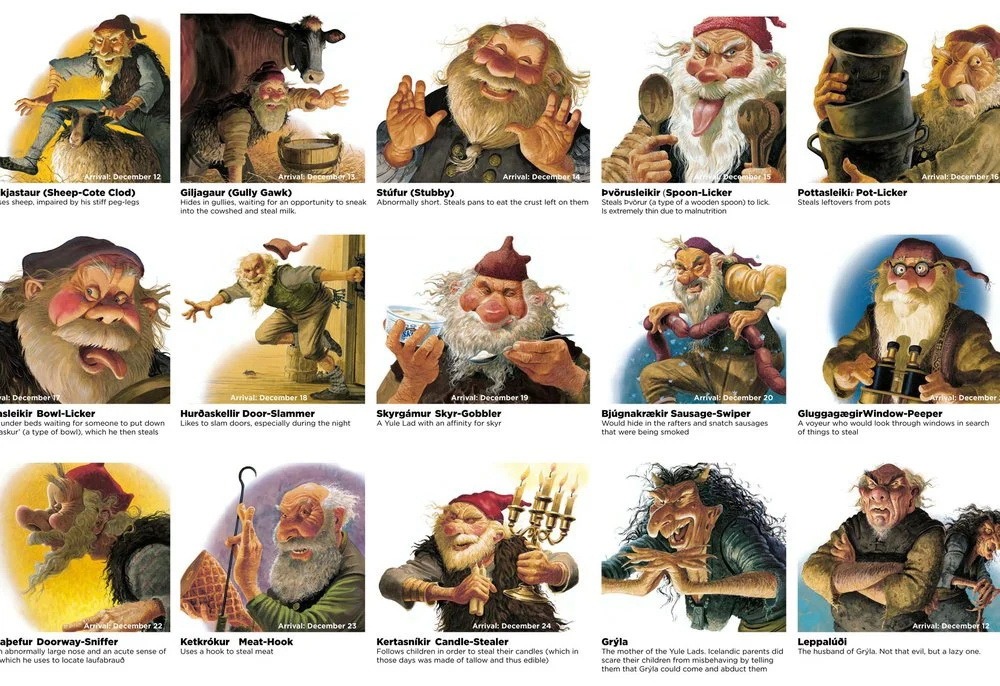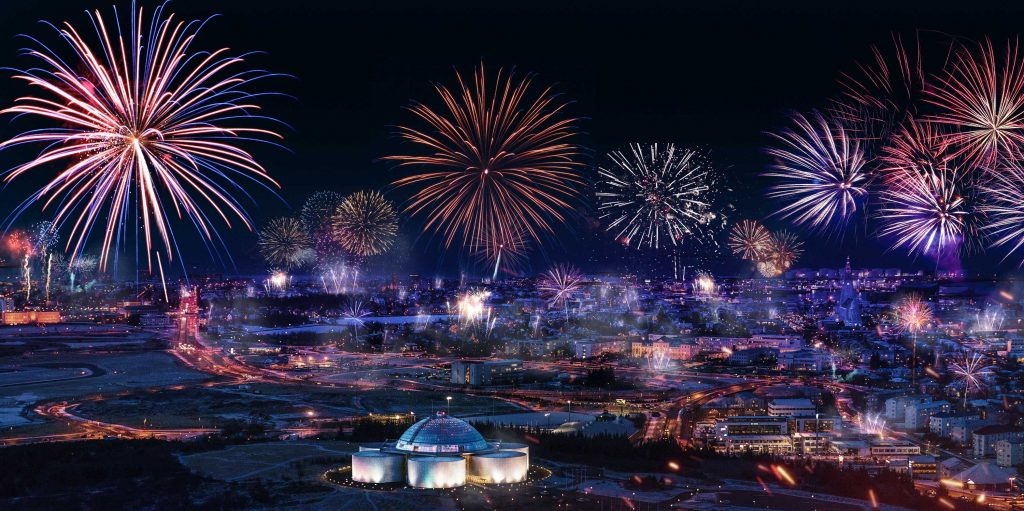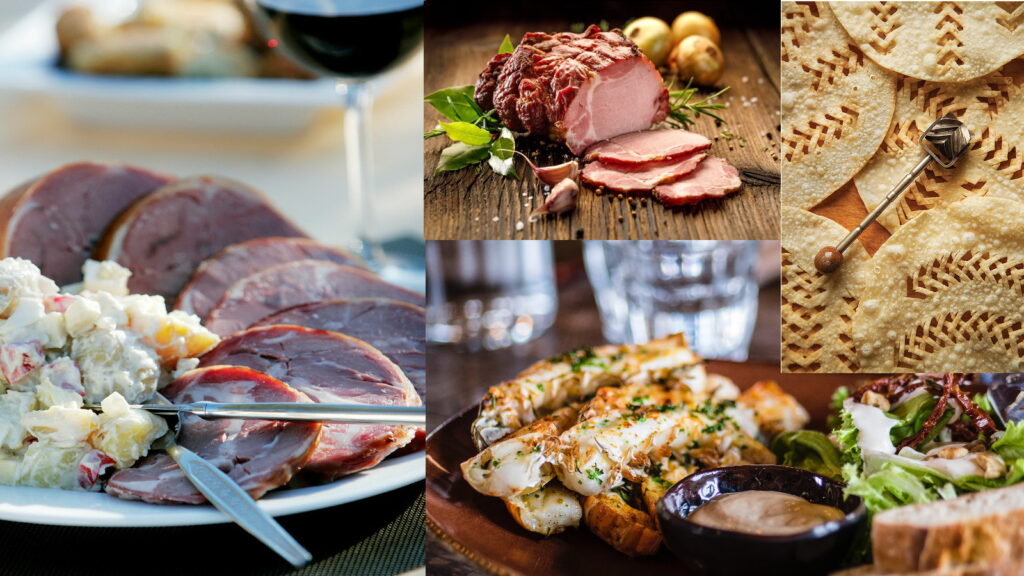Iceland, with its unbelievable nature and tiny towns, has no vanity. It is quiet and cozy all year round. Despite the harsh weather conditions, and possibly because of them, this land has a warm atmosphere even in winter.
Iceland becomes a mysterious and fabulous wonderland at Christmas and New Year periods. Everything is covered with snow, towns shining with festive decorations, and Icelanders telling stories about Yule Lads. Top Iceland Tours will share with you some sophisticated Icelandic Christmas traditions, festive food, the top 8 things to do on Christmas Eve and New Year’s Eve, and the weather.
Is there Santa Clause in Iceland?
One of the most distinctive traditions of Iceland is that it has not just 1 but 13 so-called “Santa Clauses.” However, these guys are not Santas; they are Christmas Trolls or Yule Lads (Jólasveinar). They live in rocks with their mother Grýla, father Leppalúði, and a Christmas black cat Jólakötturinn. These trolls come one by one starting from the night of December 11 (13 days before Christmas).
Every night they leave presents for obedient children in their shoes, left on the windows. But if children misbehave, they get rotten potatoes. Earlier all Yule Lads were known only for their naughty antics at night. Adults probably used to tell their children these stories to save them or correct their behavior (to prevent children from going out at a dark time and eating at night, make them sleep at night, etc.).
So here are the Christmas Trolls (Yule Lads):
- on December 12, the first Yule Lad, Sheep Cote Clod (Stekkjastaur), comes and frightens sheep;
- the next night, it is a turn for Gully Gawk (Giljagaur) to go and steal milk;
- then Stubby (Stúfur) shows up, who steals plates with stale bread;
- Spoonlicker (Þvörusleikir) steals and licks wooden spoons with long handles;
- Pot Scraper (Pottasleikir) eats leftover food from pans and pots;
- Bowl Licker (Askasleikir) hides under beds and waits to take left bowls after the nighttime meal;
- Door Slammer (Hurðaskellir) slams the door at night;
- Skyr Gobbler (Skyrgámur) eats traditional Icelandic dairy product, creamy Skyr;
- Sausage Sweeper (Bjúgnakrækir) steals smoked sausages called “bjúgu”;
- Window Peeker (Gluggagægir) likes peeking through the windows to find smth he can steal;
- Door Sniffer (Gáttaþefur) finds Christmas leaf-bread “laufabrauð” with his big nose;
- Meat Hook (Ketkrókur) steals all kinds of meat;
- Finally, on December 24, Candle Beggar (Kertasníkir) comes to steal Christmas candles.
In addition, their mother Grýla comes to towns every Christmas to take disobedient children. She can reveal them only if they repent. And in order not to be eaten by the Christmas cat, people should get some new clothes before Christmas. After December 24, all trolls, one by one, return to their home until Twelfth Night.
Christmas and New Year Traditions in Iceland
So Christmas in Iceland is surprisingly long. It lasts for 26 days! A unique Icelandic holiday aura starts on December 11 and ends on January 6. Here are the main traditions on these days:
| Date / Holiday Name | Traditions |
| The 23rd of December: St. Thorlak‘s Mass / Þorláksmessa | – people go downtown to buy the last presents;
– meet with friends and family, drink hot chocolate;
– on this day, Icelanders prefer to eat fermented skate (kæst skata);
– in Reykjavik, people gather on Laugavegur Street to do a candlelight Peace March. |
| December 24: Christmas Eve / Aðfangadagur | – at 18:00, people have dinner at home with their families;
– after dinner, they open presents;
– at midnight, some Icelanders go to church for a Christmas Mass and meet their friends and neighbors. |
| December 25: Christmas Day / Jóladagur | – people lounge and read books;
– drink non-alcoholic drink “jólaöl”;
– visit their relatives. |
| December 26: Boxing Day / Annar í Jólum | – Icelanders spend time with their families;
– go out and have a party as bars and clubs reopen after midnight. |
| December 31: New Year’s Eve / Gamlársdagur | – at 18:00 or 19:00, people have dinner;
– at 20:30, they attend bonfires;
– at 22:30, Icelanders watch a particular television comedy, “Áramótaskaupið”;
– at midnight, they do a magnificent show of fireworks for several hours. |
| January 1: New Year’s Day / Nýársdagur | – at noon in Reykjavik, people put fancy clothes and dip in Nauthólsvík geothermal beach;
– have glamorous parties at restaurants and bars. |
| January 6: Feast of the Epiphany / Þrettándinn | – to say goodbye to Christmas, Icelanders, Yule Lads, and elves gather near bonfires, dance, and sing. |
Check out Iceland’s most memorable New Year traditions – bonfires and fireworks. On the evening of December 31, Icelanders light large bonfires in every area of Reykjavik and throughout the country. That is how people burn the old year for the sake of the New Year. There are always a lot of Icelanders and a warm atmosphere with songs and dances around the fires.
At most times of the year, fireworks are prohibited in Iceland, but there is an exception for New Years’ celebrations. The Icelandic Search and Rescue Association provides all pyrotechnics. By buying fireworks, Icelanders become participants in a bright event and donate money to this volunteer organization for the needs of salvation. People start to set off fireworks from about 8:00 pm – 9:00 pm before the comedy TV show “Áramótaskaupið.” At 11:30 pm, the whole of Reykjavik goes crazy while simultaneously launching an endless number of fireworks. When New Year comes, seeing the fireworks over Reykjavik is a fantastic and impressive sight to behold.
Special Christmas Food in Iceland
The most famous Icelandic foods and drinks that people prepare for Christmas are venison, beef, turkey, salmon, herring, and seafood. Below you will find several traditional meals:
– Hung Meat (hangikjöt) is a salty smoked lamb usually served with a potato sauce “uppstúfur,” red cabbage, and peas.
– Glazed ham (hamborgarhryggur) is a hog roast with a Coca-Cola sauce, served with pickled red onion, caramelized potato, and other vegetables.
– Ptarmigan (rjúpa) is an essential dish for many Icelanders, who can not feel the authentic Christmas atmosphere without it.
– Langoustine is an Icelandic lobster that can be cooked as a soup or the main course.
– Skate (skata) is a fermented skate served with boiled or mashed potatoes. Fish smells like ammonia; however, it tastes better than it smells.
– Leaf bread (laufabrauð) is a crispy thin round bread with a beautiful pattern. They go with butter or meat.
– Sara (sörur) is an almond macaroon based on biscuits and filled with chocolate cream.
– Christmas Ale (jólaöl) is a non-alcoholic drink made of malt and orange drink Appelsín.
Top 8 things to do to feel Icelandic Christmas spirit
- Take a walk in Reykjavik. Enjoy Christmas decorations on cute colorful houses along with peace, quiet, and the stunning view of mountains. Watch a picturesque view of Reykjavík from the tower of Hallgrímskirkja church.
- Visit the Christmas Market at Hjartatorg square in the center of Reykjavik. Experience the fairy atmosphere, taste some delicious Icelandic delicacies and hot drinks, talk to Icelanders, and buy some Christmas knick-knacks. Working hours are 13:00-22:00 on the weekends, 16:00-22:00 on weekdays.
- Go ice-skating at Ingólfstorg Square. It is decorated with 100,000 light bulbs and looks charming. You will be able to rent skates and helmets. In December, it is open every day from 12:00-22:00. Sometimes ice skating is possible on the pond Tjörnin in Reykjavik.
- Go to an Icelandic church. On Christmas Eve at 18:00, all churches in Iceland have a Mass. Many churches even have a midnight Mass at 23:30, f.e. Hallgrímskirkja.
- Hunt for the Northern Lights. If the sky is clear, Christmas holidays often surprise you with magical lights dancing in green, pink, and white lanes at night.
- Relax in the Blue Lagoon. The hot spring is open every day, even on December 24 (the last booking is available at 15:00) and December 31 (the last booking is at 16:00). You should make a reservation ahead of time.
- Take a tour to explore Icelandic winter landscapes. During Christmas, Icelandic nature is often covered with snow. It makes people feel that they got into a real fairytale. Enjoy waterfalls, volcanoes, geysers, and glaciers. Also, you can visit ice caves, go snowmobiling, or go glacier hiking.
- Book a table at a restaurant in Reykjavik to taste the traditional Christmas food. Quite recently, all the restaurants were closed during Christmas and New Year Eves. Luckily, many are open these holidays. For example, Lóa Restaurant, Geiri Smart, Smokehouse, VOX, Apótek Restaurant, Grillmarket (Grillmarkaður), etc. Don’t forget to make a reservation ahead of time.
The weather during Christmas and New Year holidays in Iceland
Although Iceland is a northern country, the weather is relatively moderate in winter. It is influenced by two major streams: East Greenland (which adds frosty freshness to coastal zones) and the North Atlantic (the warm Gulf Stream). In addition, the thermometer indicators also change with the approach of drifting glaciers near eastern and northern shores. Below you will find an average temperature during December and January in different island parts.
| Month | Reykjavik (South-West Iceland)
| Vik (South Iceland)
| Akureyri (North Iceland)
|
| December | – 2°C (28°F) / +3°C (38°F) | min – 1°C / max +4°C | min – 4°C / max +2°C |
| January | – 2°C (28°F) / +2°C (36°F) | min – 1°C / max +3°C | min – 4°C / max +1°C |
Not too bad for the country of ice. Nevertheless, keep in mind the Icelandic wind. Oceanic climate provides its blowing almost non-stop. It can vary from mild and friendly to intense storms. This fact turns trips to Iceland into exciting adventures and helps to value more calm weather. By the way, it is almost sure that you will have Christmas with snow.
Merry Christmas (Gleðileg jól) and the Happy New Year (Gleðilegt Nýtt Ár) in Iceland! Remember that Iceland will warm you with its hospitality, beauty, and coziness in any weather conditions. Visiting Iceland during Christmas and New Year is an excellent opportunity to watch unique Icelandic landscapes, catch the Northern Lights, feel the festive fairy spirit, and believe in a miracle. Come and experience it on your own!




